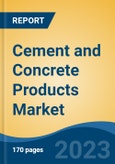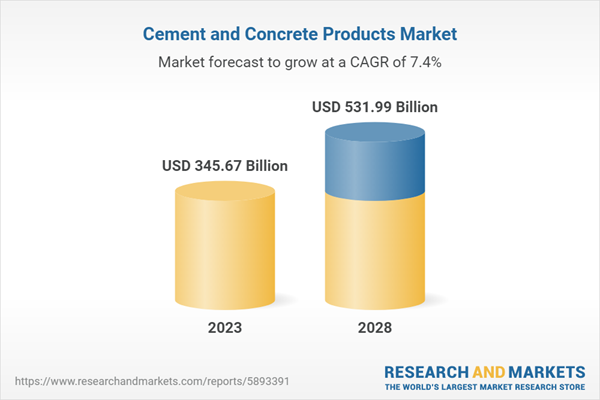Speak directly to the analyst to clarify any post sales queries you may have.
10% Free customizationThis report comes with 10% free customization, enabling you to add data that meets your specific business needs.
Cement is a powdery substance made of a mixture of calcined clay, limestone, and calcium sulfate that is mixed with water to create a paste-like substance used to bind or harden materials such as concrete, mortar, and stucco. Concrete products are made from cement and other materials such as sand, water, aggregates, and admixtures. Common concrete products include precast concrete, ready-mix concrete, framed walls, foundations, pipes, paving stones, bricks, blocks, and other building materials.
Increase in Infrastructure Spending
During 2018 to 2022, the global economy experienced continuous, sustainable expansion. The International Monetary Fund (IMF) estimates that between 2025 and 2026, real GDP will expand by 3.3% and 3.4%, respectively, globally. Additionally, emerging markets are anticipated to grow a little bit faster than developed markets during the projected period. Investments in end user markets are anticipated to rise as a result of stable economic expansion, propelling the market during the forecast period. The demand for new infrastructure is anticipated to rise in both developed and developing nations, which, in turn, will propel the growth of the global cement and concrete products market during the forecast period.The demand for cement and concrete products is anticipated to increase during the projected period as governments around the world spend more money on infrastructure projects. Many nations are putting their attention into updating aging infrastructure to accommodate growing population. For instance, Canada has committed to invest more than USD180 billion in infrastructure over the next 12 years, of which USD28.7 billion will go toward mass transit. Germany's federal government intends to invest USD147.6 billion on the construction of the nation's highways as part of its 2030 Federal Transport Infrastructure Plan. The Indian government allocated INR 233,083 crore (USD 32.02 billion) to improve the transport infrastructure in the Union Budget 2021, providing a significant boost to the infrastructure industry.
Innovations In Cement Production
The production of cement is increasingly using alternative raw materials such as clay, shale, and limestone, which will improve product quality while having a less negative impact on the environment. Limestone has historically been the primary raw material used in cement manufacture. The decarbonation of limestone throughout the production process is responsible for about 60% of the industry's CO2 emissions. Some of the natural raw materials have already been replaced by trash and byproducts from other industrial processes as a result of industry advances and R&D programs. In place of natural ingredients such as clay, shale, and limestone, by-products and waste materials such as calcium, silica, alumina, and iron are employed as alternative binding materials in the production of cement.For occurrence, in Europe, around 3%-4% of the crude materials required to create clinker, or around 14.5 million tons every year, are made up of elective crude materials and fuel fiery remains. Whereas routine Portland cement can contain up to 95% of clinker and the remaining 5% of gypsum, the clinker-to-cement proportion within the EU27 is just 73.7%.Dalmia Cement and FLSmidth & Co. formed a partnership in 2022 to work together on the research and development of innovative solutions for the production of cement. Due to these growing innovations, the global cement and concrete products market is expected to grow in near future.
Rapid Urbanization will boost the market in the forecast period
The demand for cement and concrete products is anticipated to increase during the projection period due to rapidly expanding urban population. The demand for infrastructure is anticipated to rise dramatically in Asian nations, including China, India, Vietnam, and the Philippines. 56.61% of the world's population reside in urban regions in 2021, and by 2050, that number is projected to rise to 68%. 4.46 billion people reside in urban areas in year 2021. In 2021, Asia had the second-fastest population growth rate (1.98%), trailing only Africa (3.56%). The pace of population increase in Europe is the slowest, at 0.32%. Rapid urban population growth necessitates large cement and concrete product consumption, which, in turn, will propel the growth of the market during the projection period.IoT in Cement Manufacturing
In order to increment plant efficiency, cement fabricating offices are progressively utilizing advanced innovations such as the internet of things (IoT).The Internet of Things (IoT) is a network of physical objects that connect online. IoT supports remote plant monitoring and proactive maintenance. Enormous vehicle activities in quarries are observed from a distance, and basic measurements such aslike fuel use per ton and it are accounted for to work hours. IoT can be utilizsed to anticipate forthcoming issues and keep check on that.. Predictive maintenance can increase the uptime of crucial cement machinery, such as grinding mills and kilns, in cement plants.Company can integrate IoT solutions at the locations of truck stacking, security checks, confirmation, and development. For instance, Coforge assisted numerous cement manufacturers in 2022. It used to take eight hours to physically complete this work. After IoT was put in place, the cycle was reduced to 3 hours. Other IoT uses in the cement sector include reporting on conformity with international standards, monitoring the durability of concrete mixtures, and connected logistics to boost quarry output. Manufacturers of equipment for manufacturing ready-mix concrete Zoomlin is currently investigating data-based metrics to enhance the performance of trucks used in quarries. Thus, the global cement and concrete products market is expected to grow during the forecast period.
Adoption Of Cement In Road Construction
The historical period saw an upsurge in the demand for cement due to the quick use of cement for road construction. In terms of functionality and cost, concrete roads are vastly superior than traditional asphalt roads. Cement has a number of benefits when building roads, including durability and a low maintenance requirement. Concrete roads offer superior skid resistance than asphalt roads and are impervious to water. According to a research by the Indian Central Road Research Institute (CRRI), large freight vehicles use 15%-20% less fuel on concrete roads than on asphalt-built ones. For the construction of all new road projects, the Government of India has chosen cement over bitumen on the grounds that it will last longer and be less expensive to maintain in the long term. Cement and concrete products have expanded as a result of the growing use of cement in road construction.Rigorous Regulations on Emissions from Cement Plants may impact the market
Strict controls on emissions from cement manufacturing plants are anticipated to have an impact on the global cement and concrete products markets. Governments all over the world have put tight regulations in place to decrease the amount of carbon emissions produced by the cement sector. For instance, under the Clean Air Act, the United States Environmental Protection Agency (US EPA) controls cement plant emissions. Fly ash has no longer being included in concrete mixtures because of EPA rules. Global cement producers are anticipated to reduce some of their capacity as a result of stricter environmental regulations, according to a analysis. For instance, China's cement production capacity is predicted to decline in 2023 at an average annual rate of 3%. For cement manufacturers, these laws are anticipated to result in higher operational and compliance costs, which will impede market expansion during the forecast period.Market Segmentation
The global cement and concrete products market is segmented based on type, product, application, and region. Based on type, the market is segmented into cement, ready-mix concrete, concrete pipe, brick & block, and other concrete products. Based on product, the market is segmented into rapid hardening cement, low heat cement, white cement, hydrophobic cement, and other products. Based on application, the market is segmented into residential and non-residential. Based on region, the market is further bifurcated into North America, Asia-Pacific, Europe, South America, and Middle East & Africa.Market players
Major market players in the global cement and concrete products market are Heidelberg Cement, Lafarge Holcim, CRH plc, The Siam Cement Group, Titan Cement Company S.A., Aditya Birla Ultratech, Mitsubishi Cement Corporation, CNBM International Corporation, Drake Cement LLC, and Taiheiyo Cement Corporation.Report Scope:
In this report, the Global Cement and Concrete Products Market has been segmented into the following categories, in addition to the industry trends which have also been detailed below:Cement and Concrete Products Market, By Type:
- Cement
- Ready-Mix Concrete
- Concrete Pipe
- Brick and Block
- Other Concrete Products
Cement and Concrete Products Market, By Product:
- Rapid Hardening Cement
- Low Heat Cement
- White Cement
- Hydrophobic Cement
- Other Products
Cement and Concrete Products Market, By Application:
- Residential
- Non-Residential
Cement and Concrete Products Market, By Region:
- North America
- United States
- Canada
- Mexico
- Asia-Pacific
- China
- India
- Japan
- South Korea
- Australia
- Europe
- Germany
- United Kingdom
- France
- Spain
- Italy
- South America
- Brazil
- Argentina
- Colombia
- Middle East
- Saudi Arabia
- South Africa
- UAE
Competitive Landscape
Company Profiles: Detailed analysis of the major companies present in the global cement and concrete products market.Available Customizations:
With the given market data, the publisher offers customizations according to a company's specific needs.This product will be delivered within 1-3 business days.
Table of Contents
Companies Mentioned
- Heidelberg Cement
- Lafarge Holcim
- CRH plc
- The Siam Cement Group
- Titan Cement Company S.A.
- Aditya Birla Ultratech
- Mitsubishi Cement Corporation
- CNBM International Corporation
- Drake Cement LLC
- Taiheiyo Cement Corporation
Table Information
| Report Attribute | Details |
|---|---|
| No. of Pages | 170 |
| Published | October 2023 |
| Forecast Period | 2023 - 2028 |
| Estimated Market Value ( USD | $ 345.67 Billion |
| Forecasted Market Value ( USD | $ 531.99 Billion |
| Compound Annual Growth Rate | 7.4% |
| Regions Covered | Global |
| No. of Companies Mentioned | 10 |









